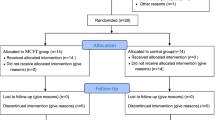Abstract
Background and aims: Previous research on various fall prevention strategies, in an effort to help the aging population has lead to inconsistent results. In this experiment, an 8-week computerized training program with a feedback fading protocol was given to 12 community-dwelling elderly subjects twice a week. Methods: Postural sway (force plate measures), attentional demands (dual-task paradigm), the Berg Balance Scale and the Activities-specific Balance Confidence Scale (ABC) were measured in pre-, post-, and retention test assessments. Results: Results indicated that the experimental group showed a significant decrease in reaction time during standing compared with the control group, and the difference remained significant even after a two-week period (retention test). Postural sway and ABC results showed no significant changes between groups in either post-test or retention test. The Berg Balance Scale scores were significantly higher in the post-test compared with the pre-test. The Berg scale is a functional mobility scale, and the increase observed may be associated with a decrease of at least 4% in the risk of falling. This study further illustrates that postural sway (mode frequency) may not be the best variable to measure the efficiency of a treatment or training protocol. Reaction time in the dual-task paradigm, which was used to measure attentional demands during posture, was found to be affected more by the training program. Conclusions: Postural training in combination with a feedback fading protocol seems to improve the automaticity of posture significantly.
Similar content being viewed by others
References
Kannus P, Parkkari J, Koskinen S, et al. Fall-induced injuries and deaths among older adults. JAMA 1999; 281: 1895–9.
Tinetti M, Speechley M. The prevention of falls among the elderly. N Engl J Med 1989; 320: 1055–9.
Spirduso WW, Cronin DL. Exercise dose-response effects on quality of life and independent living in older adults. Med Sci Sports Exerc 2001; 33(Suppl 6): S598–608 (discussion S609–10).
Carter ND, Kannus P, Khan M. Exercise in the prevention of falls in older people. A systematic literature review examining the rationale and the evidence. Sports Med 2001; 31: 427–38.
Mulrow CD, Gerety MB, Kanten D, et al. A randomized trial of physical rehabilitation for very frail nursing home residents. JAMA 1994; 271: 519–24.
Lord SR, Ward JA, Williams P, Strudwick M. The effect of a 12-month exercise trial on balance, strength, and falls in older women: a randomized controlled study. J Am Geriatr Soc 1995; 43: 1198–206.
Campbell AJ, Robertson MC, Gardner MM, Norton RN, Tilyard MW, Buchner DM. Randomized controlled trial of a general practice programme of home based exercise to prevent falls in elderly women. BMJ 1997; 315: 1065–9.
Buchner DM, Cress ME, de Lateur BJ, et al. The effect of strength and endurance training on gait, balance, fall risk and health services use in community-living older adults. J Gerontol 1997; 52: M218–24.
Wolf SL, Barnhart HX, Kutner NG, McNeely E, Coogler C, Xu T. Reducing frailty and falls in older persons: an investigation of Tai Chi and computerized balance training. J Am Geriatr Soc 1996; 44: 489–97.
Kutner NG, Barnhart H, Wolf SL, McNeely E, Xu T. Self-report benefits of Tai Chi practice by older adults. J Gerontol 1997; 52: P242–6.
Wolf SL, Coogler C, Xu T. Exploring the basis of Tai Chi Chuan as a therapeutic exercise approach. Arch Phys Med Rehabil 1977; 78: 886–92.
Horak FB. Effects of neurological disorders on postural movement strategies in the elderly. In Vellas B, Toupet M, Rubenstein L, et al, Eds. Falls, balance and gait disorders in the elderly. Paris: Elsevier, 1992: 137–52.
Baloh RW, Jacobson KM, Enrietto JA, Corona S, Honrubia V. Balance disorders in older persons: Quantification with posturography. Otolaryngol Head Neck Surg 1998; 119: 89–92.
Hu MH, Woollacott MH. Multisensory training of standing balance in older adults: I. Postural stability and one-leg stance balance. J Gerontol 1994; 49: M52–61.
Stelmach GE, Worringham CJ. Sensorimotor deficits related to postural stability. Clin Geriatr Med 1985; 3: 679–94.
Kerr B, Condon SM, McDonald LA. Cognitive spatial processing and the regulation of posture. J Exp Psychol 1985; 11: 617–22.
Lajoie Y, Teasdale N, Bard C, Fleury M. Upright standing and gait: Are there changes in attentional requirements related to normal aging? Exp Aging Res 1996; 22: 185–98.
Shumway-Cook A, Baldwin M, Polissar NL, Gruber W. Predicting the probability for falls in community-dwelling older adults. Phys Ther 1997; 77: 812–9.
Powell LE, Myers AM. The Activities-specific balance confidence (ABC) Scale. J Gerontol 1995; 50: M28–34.
Woollacott M, Shumway-Cook A. Attention and the control of posture and gait: a review of an emerging area of research. Gait Posture 2002; 16: 1–14.
Skinner HB, Barrack RL, Cook SD. Age-related decline in pro-prioception. Clin Orthop Relat Res 1984; 184: 208–11.
Straube A, Botzel K, Hawken M, Paulus W, Brandt T. Postural control in the elderly: Differential effects of visual, vestibular and somatosensory input. In Amblard B, Berthoz A, Clarac F, Eds. Posture and gait: development, adaptation and modulation. Amsterdam: Elsevier, 1988: 105–14.
Assaiante C, Amblard B. An ontogenetic model for sensorimotor organization of balance control in humans. Hum Mov Sci 1995; 14: 13–43.
Perrin P, Jeandel C, Perrin C, Béné MC. Influence of visual control, conduction and central integration on static and dynamic balance in healthy older adults. Gerontology 1997; 43: 223–31.
Winstein CJ, Schmidt RA. Reduced frequency of knowledge of results enhances motor skill learning. J Exp Psychol Learn Mem Cogn 1990; 16: 677–691.
Shumway-Cook A, Woollacott M. Motor control. Theory and practical applications, 2nd Ed. New York: Lippincott Williams & Wilkins, 2001.
Author information
Authors and Affiliations
Corresponding author
Rights and permissions
About this article
Cite this article
Lajoie, Y. Effect of computerized feedback postural training on posture and attentional demands in older adults. Aging Clin Exp Res 16, 363–368 (2004). https://doi.org/10.1007/BF03324565
Received:
Accepted:
Published:
Issue Date:
DOI: https://doi.org/10.1007/BF03324565




